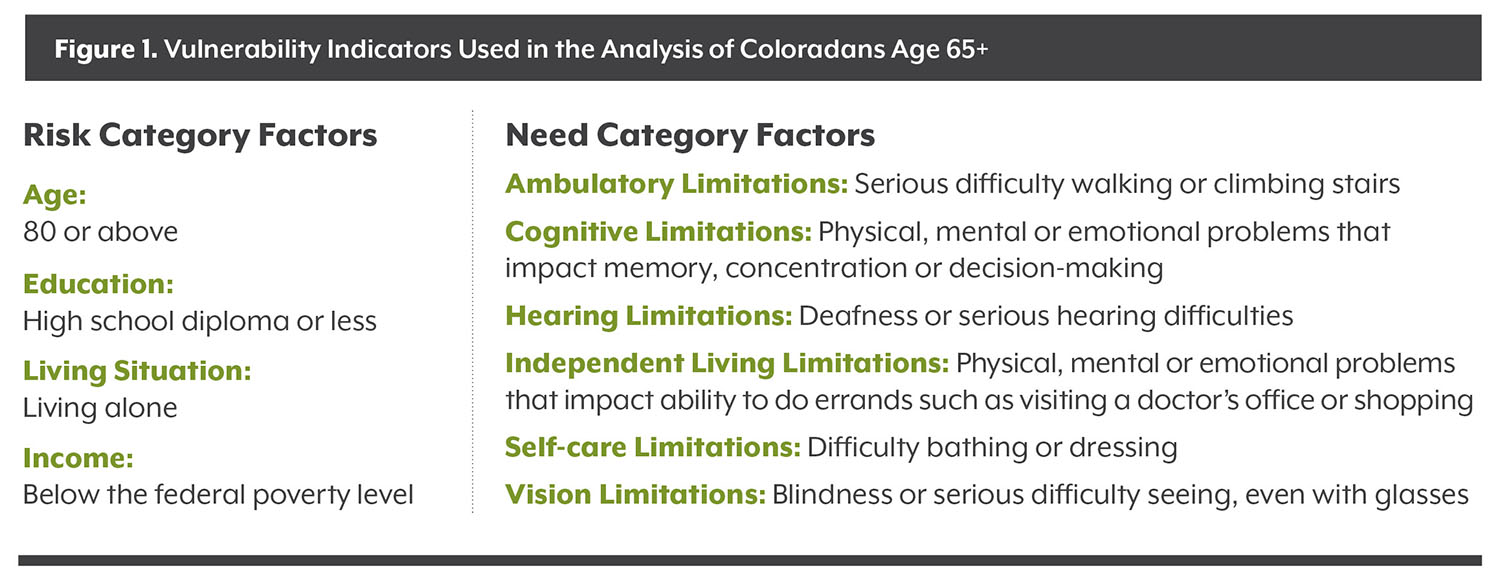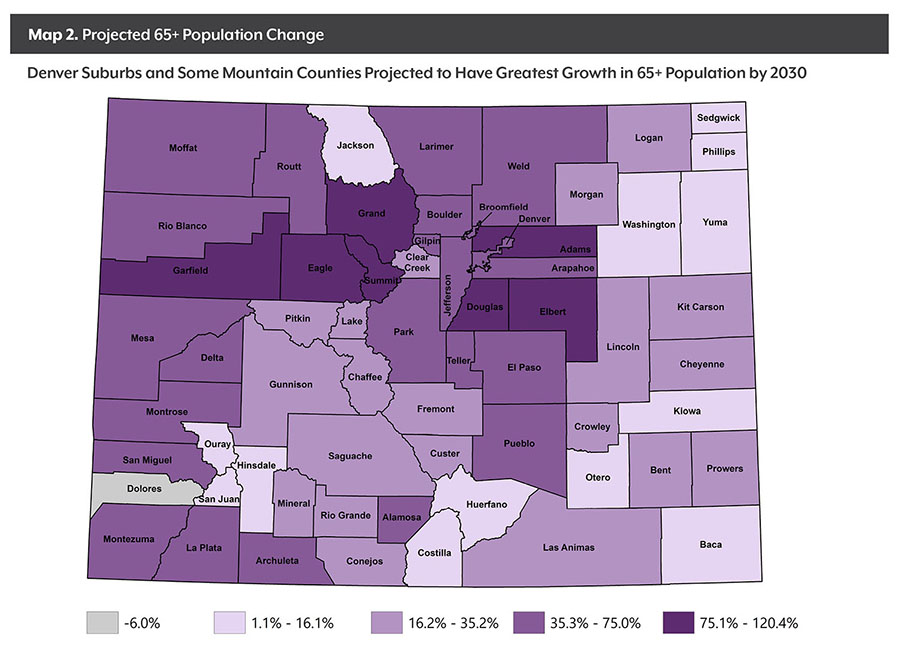Drivers of Vulnerability: Risk Factors
When solely considering the four risk-based measures — the demographic factors that often spell vulnerability for seniors — Colorado’s overall score is 4.5. However, risk scores vary considerably by county. (See Risk Map Above.)
Rural counties, especially those on the Eastern Plains, had the highest risk scores. Kiowa and Washington counties each had 9.3 scores, the state’s highest.
In Washington County, 46 percent of seniors live alone, 10 percent are in poverty, 31 percent are 80 or older, and 60 percent have a high school diploma or less. In Kiowa County, 53 percent of seniors live alone, 10 percent are in poverty, 31 percent are 80 or older and 65 percent have a high school diploma or less.
Douglas and Elbert counties had risk scores of 2.0 and 2.3, some of the lowest scores among Front Range counties.
Summit, Ouray and Mineral counties had the lowest risk scores in the state of 1.5.
Drivers of Vulnerability: Need Factors
When it comes to the six need factors — the measures that show the seniors who are already experiencing physical or mental limitations — Colorado’s average score is 5.1.
As with risk, the highest concentration of seniors with needs is found in Colorado’s rural areas, including the Eastern Plains and the San Luis Valley. (See Need Map Above.)
Crowley and Costilla counties each scored a 10.0 for need, the state’s highest. Forty percent of Crowley County’s seniors have difficulty walking or climbing stairs, 28 percent have cognitive difficulties, and 32 percent face physical or mental challenges to living independently.
In Costilla County, 40 percent have difficulty walking or climbing stairs, 35 percent have hearing difficulties and 28 percent have challenges to living independently.
Front Range and Ski Country counties have the lowest need scores. In Park County, with Colorado’s lowest need score of 1.2, just 11 percent of seniors report difficulties walking or climbing stairs, two percent have cognitive difficulties, 10 percent have hearing limitations and one percent have self-care limitations.
A Nuanced Picture: Where Risk and Need Don’t Align
CHI’s analysis found some surprising contradictions, evidence that each county and community is home to seniors with unique risks and needs.
These scores can help providers and policymakers develop plans to address the unique challenges in their counties.
Some of the nuanced findings:
- Sedgwick and Rio Blanco counties score relatively high on risk, with many older adults having a high school diploma at most or less or living alone. But relatively few residents in these counties struggle with ambulatory, cognitive or independent living limitations.
- Tiny Mineral and San Juan counties have lower risk scores, with fewer seniors living in poverty and relatively low rates of adults over age 80. Yet these residents are more likely to struggle with independent living or hearing limitations.
- Seniors in Cheyenne County have some of the highest levels of hearing limitations and difficulties walking or climbing stairs. But they also report some of the lowest rates of self-care or independent living limitations.
- Boulder County has a relatively high rate of older adults living alone, but its seniors report few other demographic risk factors and modest physical limitations, resulting in a score of 3.8.
Overall, seniors in counties in the mountain region tend to have higher levels of risk but fewer needs: Seniors are more likely to live alone and to be above 80, but they don’t report as many need factors. Older adults in these communities may benefit from programs that help seniors keep up with chores and home repairs, or a volunteer network for snow removal.
Counties along the state’s southwest corner have lower risk scores but higher need scores. Seniors here face higher rates of hearing and mobility limitations, even though the counties have relatively few older adults living in poverty.
Seniors in higher-population counties along the Front Range tend to have relatively higher incomes and educational attainment. These communities may have high demand for specialized transportation or in-home caregiving.
Conclusion
As Colorado’s population ages, ensuring that seniors have access to health care, supports and safe environments will be an increasingly significant health policy undertaking for the state.
This analysis shows that what seniors will need will vary by county. A one-size-fits-all strategy for supporting Colorado’s older adults will not be effective and it won’t be an efficient use of resources.
The Aging Vulnerability Index is intended to help advocates, policymakers and others assess the characteristics of their senior residents as they determine the best policies, programs, and plans to meet their seniors’ needs. A deeper dive into the indicators will help stakeholders who are working to meet the needs of their changing populations.





